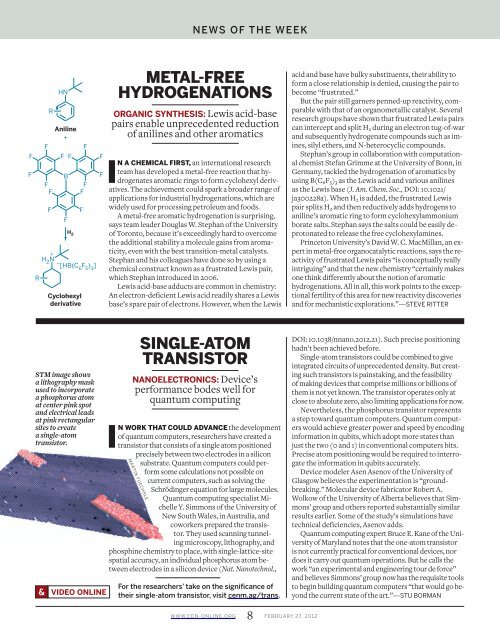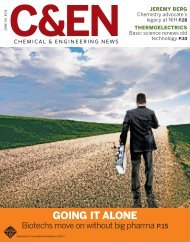February 27, 2012 - IMM@BUCT
February 27, 2012 - IMM@BUCT
February 27, 2012 - IMM@BUCT
Create successful ePaper yourself
Turn your PDF publications into a flip-book with our unique Google optimized e-Paper software.
NEWS OF THE WEEK<br />
F<br />
F<br />
R<br />
F<br />
R<br />
F<br />
F<br />
F<br />
H 2 N +<br />
HN<br />
Aniline<br />
+<br />
F<br />
B<br />
F<br />
F<br />
H 2<br />
F<br />
F<br />
F<br />
Cyclohexyl<br />
derivative<br />
F<br />
– [HB(C 6 F 5 ) 3 ]<br />
F<br />
F<br />
METAL-FREE<br />
HYDROGENATIONS<br />
ORGANIC SYNTHESIS: Lewis acid-base<br />
pairs enable unprecedented reduction<br />
of anilines and other aromatics<br />
IN A CHEMICAL FIRST, an international research<br />
team has developed a metal-free reaction that hydrogenates<br />
aromatic rings to form cyclohexyl derivatives.<br />
The achievement could spark a broader range of<br />
applications for industrial hydrogenations, which are<br />
widely used for processing petroleum and foods.<br />
A metal-free aromatic hydrogenation is surprising,<br />
says team leader Douglas W. Stephan of the University<br />
of Toronto, because it’s exceedingly hard to overcome<br />
the additional stability a molecule gains from aromaticity,<br />
even with the best transition-metal catalysts.<br />
Stephan and his colleagues have done so by using a<br />
chemical construct known as a frustrated Lewis pair,<br />
which Stephan introduced in 2006.<br />
Lewis acid-base adducts are common in chemistry:<br />
An electron-deficient Lewis acid readily shares a Lewis<br />
base’s spare pair of electrons. However, when the Lewis<br />
acid and base have bulky substituents, their ability to<br />
form a close relationship is denied, causing the pair to<br />
become “frustrated.”<br />
But the pair still garners penned-up reactivity, comparable<br />
with that of an organometallic catalyst. Several<br />
research groups have shown that frustrated Lewis pairs<br />
can intercept and split H 2 during an electron tug-of-war<br />
and subsequently hydrogenate compounds such as imines,<br />
silyl ethers, and N-heterocyclic compounds.<br />
Stephan’s group in collaboration with computational<br />
chemist Stefan Grimme at the University of Bonn, in<br />
Germany, tackled the hydrogenation of aromatics by<br />
using B(C 6 F 5 ) 3 as the Lewis acid and various anilines<br />
as the Lewis base ( J. Am. Chem. Soc., DOI: 10.1021/<br />
ja300228a ). When H 2 is added, the frustrated Lewis<br />
pair splits H 2 and then reductively adds hydrogens to<br />
aniline’s aromatic ring to form cyclohexylammonium<br />
borate salts. Stephan says the salts could be easily deprotonated<br />
to release the free cyclohexylamines.<br />
Princeton University’s David W. C. MacMillan , an expert<br />
in metal-free organocatalytic reactions, says the reactivity<br />
of frustrated Lewis pairs “is conceptually really<br />
intriguing” and that the new chemistry “certainly makes<br />
one think differently about the notion of aromatic<br />
hydrogenations. All in all, this work points to the exceptional<br />
fertility of this area for new reactivity discoveries<br />
and for mechanistic explorations.” —STEVE RITTER<br />
STM image shows<br />
a lithography mask<br />
used to incorporate<br />
a phosphorus atom<br />
at center pink spot<br />
and electrical leads<br />
at pink rectangular<br />
sites to create<br />
a single-atom<br />
transistor.<br />
VIDEO ONLINE<br />
NANOELECTRONICS: Device’s<br />
performance bodes well for<br />
quantum computing<br />
IN WORK THAT COULD ADVANCE the development<br />
of quantum computers, researchers have created a<br />
transistor that consists of a single atom positioned<br />
precisely between two electrodes in a silicon<br />
MARTIN FUECHSLE<br />
SINGLE-ATOM<br />
TRANSISTOR<br />
substrate. Quantum computers could perform<br />
some calculations not possible on<br />
current computers, such as solving the<br />
Schrödinger equation for large molecules.<br />
Quantum computing specialist Michelle<br />
Y. Simmons of the University of<br />
New South Wales, in Australia, and<br />
coworkers prepared the transistor.<br />
They used scanning tunneling<br />
microscopy, lithography, and<br />
phosphine chemistry to place, with single-lattice-site<br />
spatial accuracy, an individual phosphorus atom between<br />
electrodes in a silicon device ( Nat. Nanotechnol.,<br />
For the researchers’ take on the significance of<br />
their single-atom transistor, visit cenm.ag/trans.<br />
DOI: 10.1038/nnano.<strong>2012</strong>.21 ). Such precise positioning<br />
hadn’t been achieved before.<br />
Single-atom transistors could be combined to give<br />
integrated circuits of unprecedented density. But creating<br />
such transistors is painstaking, and the feasibility<br />
of making devices that comprise millions or billions of<br />
them is not yet known. The transistor operates only at<br />
close to absolute zero, also limiting applications for now.<br />
Nevertheless, the phosphorus transistor represents<br />
a step toward quantum computers. Quantum computers<br />
would achieve greater power and speed by encoding<br />
information in qubits, which adopt more states than<br />
just the two (0 and 1) in conventional computers bits.<br />
Precise atom positioning would be required to interrogate<br />
the information in qubits accurately.<br />
Device modeler Asen Asenov of the University of<br />
Glasgow believes the experimentation is “groundbreaking.”<br />
Molecular device fabricator Robert A.<br />
Wolkow of the University of Alberta believes that Simmons’<br />
group and others reported substantially similar<br />
results earlier. Some of the study’s simulations have<br />
technical deficiencies, Asenov adds.<br />
Quantum computing expert Bruce E. Kane of the University<br />
of Maryland notes that the one-atom transistor<br />
is not currently practical for conventional devices, nor<br />
does it carry out quantum operations. But he calls the<br />
work “an experimental and engineering tour de force”<br />
and believes Simmons’ group now has the requisite tools<br />
to begin building quantum computers “that would go beyond<br />
the current state of the art.” —STU BORMAN<br />
WWW.CEN-ONLINE.ORG 8 FEBRUARY <strong>27</strong>, <strong>2012</strong>

















